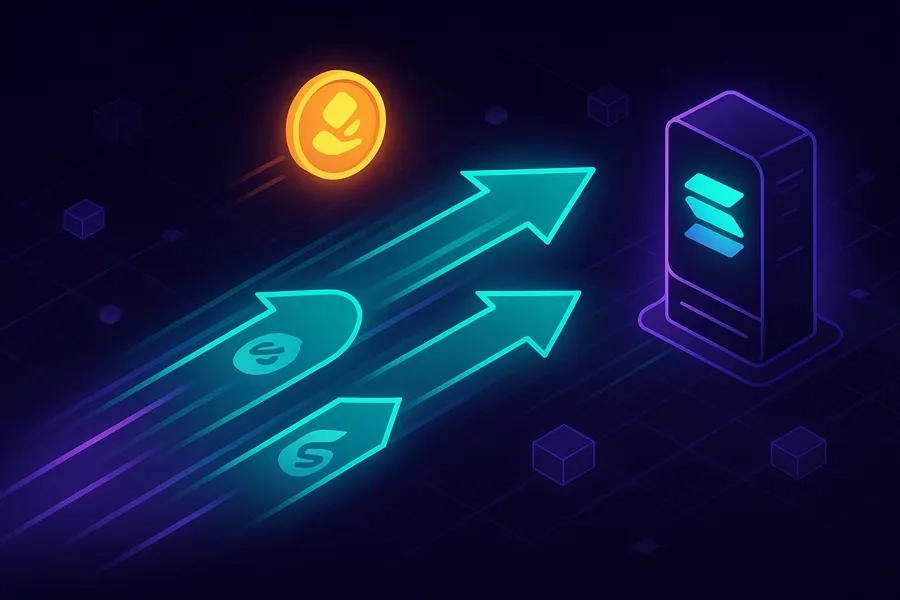What is the Best Project on Solana?
The blockchain industry is constantly evolving, and the question many investors ask is: what is the best project on Solana? Known for its speed and low costs, Solana has quickly positioned itself as one of the most prominent blockchain networks, competing with Ethereum and other giants. Its Proof of History (PoH) consensus, combined with scalability and near-zero fees, makes it a leading platform for decentralized finance (DeFi), NFTs, and Web3 gaming.
Yet, as blockchain adoption grows, competing projects are emerging with unique technical features and scalability solutions, challenging Solana’s dominance. To understand what makes Solana stand out—and whether other blockchains could surpass it—we need to look closely at both Solana’s current ecosystem and the strongest rivals rising in the space.
Solana: A New Generation Blockchain
Despite being relatively young compared to Ethereum, Solana has built a robust infrastructure that appeals to developers and investors alike. Its Proof of History (PoH) mechanism ensures fast and secure transactions, making it one of the most efficient blockchain platforms today.
- Transaction Speed & Cost: Capable of processing thousands of transactions per second (TPS) with fees close to zero.
- Ecosystem Growth: A hub for DeFi apps, NFT marketplaces, and Web3 gaming projects.
- Resilience: Despite facing outages and congestion in the past, Solana has consistently recovered and maintained user trust.
Solana’s growth, however, has not gone unchallenged. Several new blockchain projects—dubbed “Solana killers”—are now competing by addressing scalability, security, and decentralization issues.
The Top 5 Projects Competing with Solana
1. SUI – Parallel Scalability at Scale
SUI is one of the most innovative Layer 1 blockchains, designed for parallel transaction processing. Unlike Solana, which processes transactions sequentially, SUI executes them simultaneously, significantly boosting scalability during peak demand.
Key highlights:
- Narwhal & Bullshark Consensus: Enhances speed and ensures data verification.
- Gasless Transactions: Focused on accessibility and lower costs.
- ZK Integration: Adds privacy and advanced cryptographic security.
With a market cap of $4.7 billion, SUI is rapidly climbing the charts and could surpass $10 billion in the near term.
2. Aptos – The “Solana Killer”
Often called a direct rival, Aptos leverages the Move programming language for smart contracts, designed to enhance scalability and developer experience.
Key highlights:
- Parallel Execution: Similar to SUI, Aptos processes multiple transactions at once.
- Byzantine Fault Tolerance (BFT): Ensures rapid finality with high security.
- Upgradable Contracts: Future-proof design to adapt without halting operations.
Currently valued at $4 billion, Aptos continues to expand its developer ecosystem and attract institutional interest.
3. Cardano – The Academic Rival
Cardano is built on rigorous academic research and peer-reviewed protocols, making it one of the most scientifically grounded blockchains.
Key highlights:
- Ouroboros Proof-of-Stake (PoS): Energy-efficient and secure.
- Hydra Scaling Solution: Potential to support millions of TPS.
- Haskell-Based Smart Contracts: Formal methods ensure security and decentralization.
With a $13.8 billion market cap, Cardano remains in the global top 10 and could rival Solana if its Hydra upgrade reaches full adoption.
4. The Open Network (TON) – Powered by Telegram
Originally developed by Telegram’s team, TON uses dynamic sharding to optimize scalability and Proof-of-Stake to handle massive throughput.
Key highlights:
- Web3 Integration: Supports decentralized storage, DNS, and micropayments.
- Telegram User Base: Strong adoption pipeline through mini-games and integrated apps.
- Market Position: Currently ranked 7th globally with a $14.4 billion market cap.
TON’s mainstream adoption potential makes it one of Solana’s strongest competitors.
5. Fantom – DAG-Powered Innovation
Fantom employs a Directed Acyclic Graph (DAG) structure and its unique Lachesis consensus, enabling high throughput and low fees.
Key highlights:
- SONIC Upgrade: Expected to boost network efficiency and validator incentives.
- DeFi Hub: A thriving ecosystem with growing cross-chain integrations.
- Market Position: Valued at $1.9 billion, with room for rapid growth.
Though still behind Solana, Fantom’s technical upgrades could position it as a long-term rival.
What is the Best Project on Solana? The Bigger Picture
When analyzing what is the best project on Solana, it’s important to recognize that Solana itself remains one of the strongest blockchain ecosystems. Projects within Solana—such as Serum (DeFi), Magic Eden (NFTs), and Star Atlas (gaming)—are already pushing boundaries in Web3 adoption.
At the same time, external rivals like SUI, Aptos, Cardano, TON, and Fantom are innovating aggressively and could outpace Solana in certain niches.
FAQs: What is the Best Project on Solana?
Q1: What is the best project on Solana right now?
Currently, Magic Eden (NFTs) and Serum (DeFi) are among the most impactful projects in the Solana ecosystem.
Q2: Why is Solana considered better than other blockchains?
Solana is known for its speed, scalability, and extremely low fees, making it ideal for DeFi, NFTs, and gaming applications.
Q3: Could SUI or Aptos replace Solana as the leading blockchain?
Both SUI and Aptos offer parallel transaction processing, giving them scalability advantages. However, Solana’s established ecosystem still gives it an edge.
Q4: What is the best project on Solana for investors?
From an investment perspective, DeFi platforms like Serum and NFT marketplaces like Magic Eden offer some of the strongest use cases on Solana.
Conclusion: The Race for Blockchain Dominance
While Solana remains a leader in blockchain innovation, the question of what is the best project on Solana is both ecosystem-specific and industry-wide. Inside its network, projects like Serum and Magic Eden are driving adoption. Outside, blockchains like SUI, Aptos, TON, Cardano, and Fantom are vying for dominance with new consensus mechanisms and scalability models.
The blockchain race is far from over. Solana may continue to lead, but the rise of powerful rivals ensures that innovation—and competition—will remain fierce.

